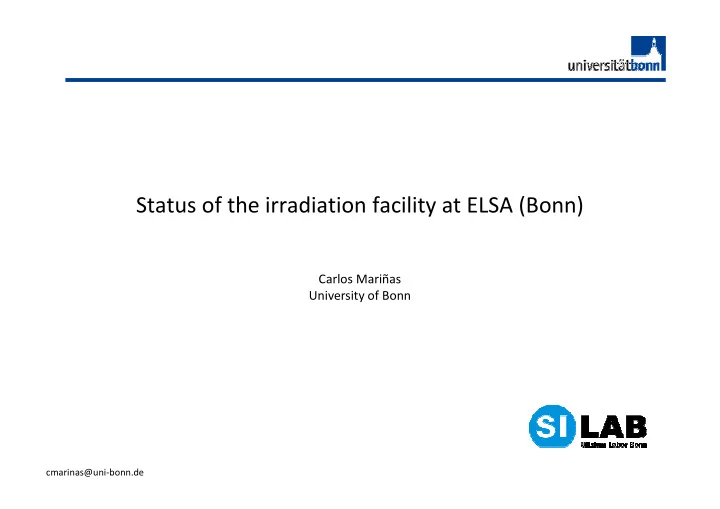

Status of the irradiation facility at ELSA (Bonn) Carlos Mariñas University of Bonn cmarinas@uni-bonn.de
Outline • ELSA facility • Linac 1 operation point • Beam characterization • Trovidur foils Trovidur foils • p-i-n diodes • Dosimetry • radFET • Aminogray • Conclusions 2 cmarinas@uni-bonn.de
ELSA (Elektronen-Stretcher-Anlage) Electron Stretcher Accelerator ELSA is operated at the Physics Institute of the University of Bonn. It consists of three stages (LINACs, booster and stretcher ring) and delivers a beam of polarized or unpolarized electrons with variable energy of a maximum of 3.5 GeV. 3 cmarinas@uni-bonn.de
Irradiation facility Linac 1 20±2 MeV e - Dedicated room for irradiations 4 cmarinas@uni-bonn.de
Linac 1 operation point Problems found in the last irradiation campaign: ELSA runs always in high current, high frequency and small beam size mode → Extremely high currents in small areas Dose rates of tens of Mrad per minute! New parameters with moderate doses Expected dose at ELSA entire area a (cm) 3,00cm o Linac 1 b (cm) 3,00cm Frequencies: up to 50Hz Pulse duration (1ns, 1– 3µs) 1,00E-06s Pulses: 1ns, 1-3us Pulse frequency 25,00Hz Charge: down to 1nC per pulse Charge in beam / pulse 1,00E-09C 8,61krad/min Dose per min. 5 cmarinas@uni-bonn.de
Beam characteristics: spot size 0.4 mm Trovidur foil 0.4 mm Trovidur foil after 4 hours of irradiation Beam spot size ~ 6x6 cm 2 6 cmarinas@uni-bonn.de
Beam characteristics: current distribution Scan the full beam spot area with Pt100 a pin diode on XY motorstages Cooling p-i-n Temperature under control Constant current delivered by the Linac Data taking First tests 7 cmarinas@uni-bonn.de
Beam spot We can even sit in the periphery of the beam spot and reduce even more the dose rate if needed Beam spot ~6x6cm2 8 cmarinas@uni-bonn.de
Beam current 4mm Trovidur foil melted in minutes Linear response in the p-i-n diode at low currents → Never tested by the ELSA crew 9 cmarinas@uni-bonn.de
radFET dosimetry radFET’s are calibrated MOSFETs. The electrons created by the ionizing radiation are trapped in the oxide and shift the value of the gate threshold voltage, required to maintain a given constant drain current through the transistor. Used in LHC and Belle to measure the TID → Some pieces available from MPI and KEK 10 cmarinas@uni-bonn.de
Aminogray dosimetry The signal is dose dependent, yet is independent of the dose rate, energy type, and is relatively insensitive to temperature and humidity and can be read more than 70 days after the irradiation. Irradiating the amino acid alanine with ionizing radiation causes the production of radicals (unpaired electrons), of which the number of unpaired electrons is proportional to the dose absorbed over a wide dose range. The non-destructive readout of the radiation induced measuring signal is performed by the procedure of electron spin resonance (ESR). Used to calibrate the radFETs in the past ESR available at KEK for dose measurement. Many thanks to Tsouboyama-san! 11 cmarinas@uni-bonn.de
Future plans • Bending magnet: Will improve the knowledge of the beam • Linac 1 will deliver unpolarized electrons to the booster (hopefully more time for irradiations) • Linac 2 only for polarized electrons • In July/August a new Interlock system will be installed (ELSA shutdown) • We will ask for another long time slot in September 12 cmarinas@uni-bonn.de
Conclusions • ELSA: Irradiation facility at home • Stable operation point was found → Low dose rates (~10krad per minute) • Beam profile in Linac 1 is now under control (Trovidur and p-i-n diode) • Dosimetry ready for the next period 13 cmarinas@uni-bonn.de
Thank you very much! 14 cmarinas@uni-bonn.de
Recommend
More recommend